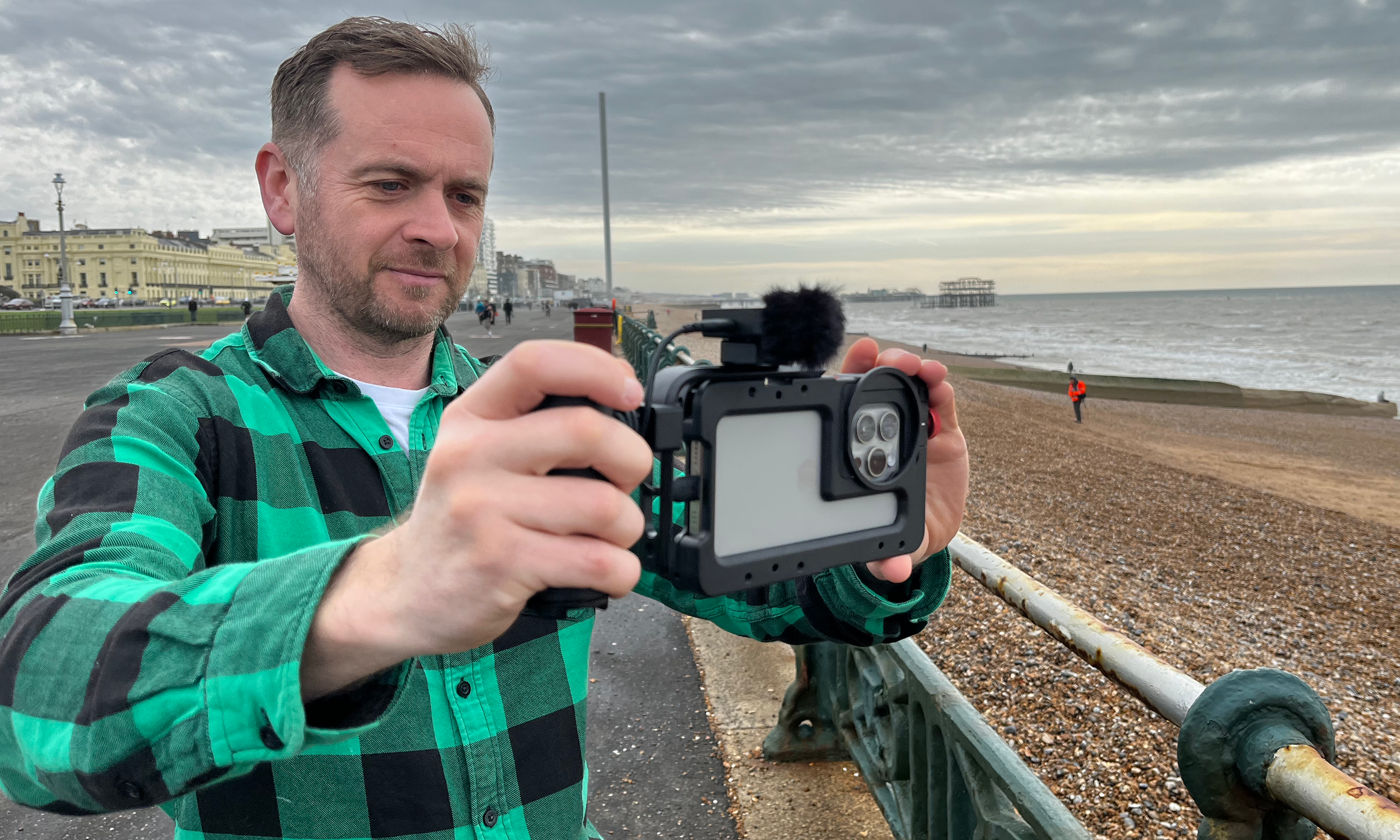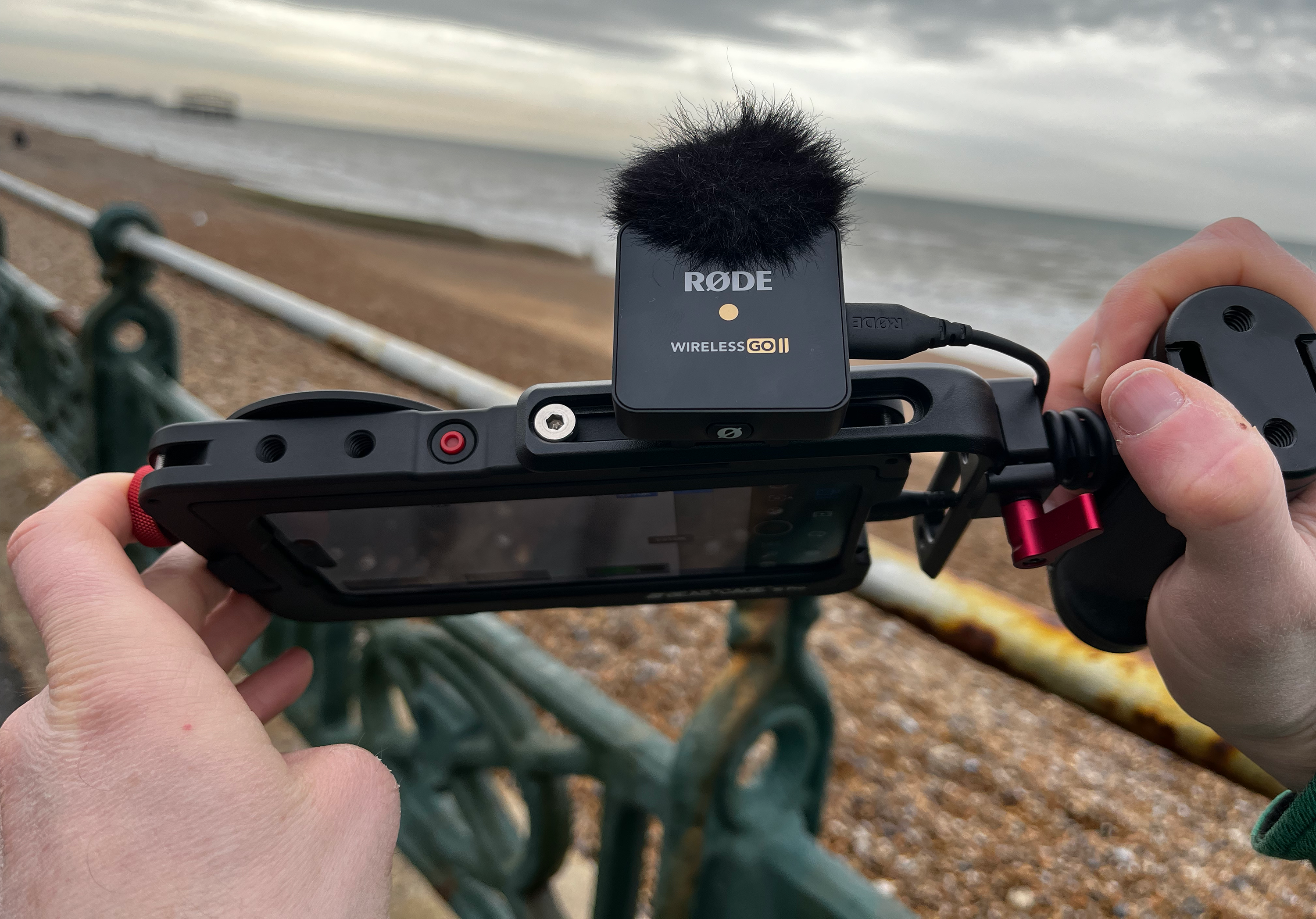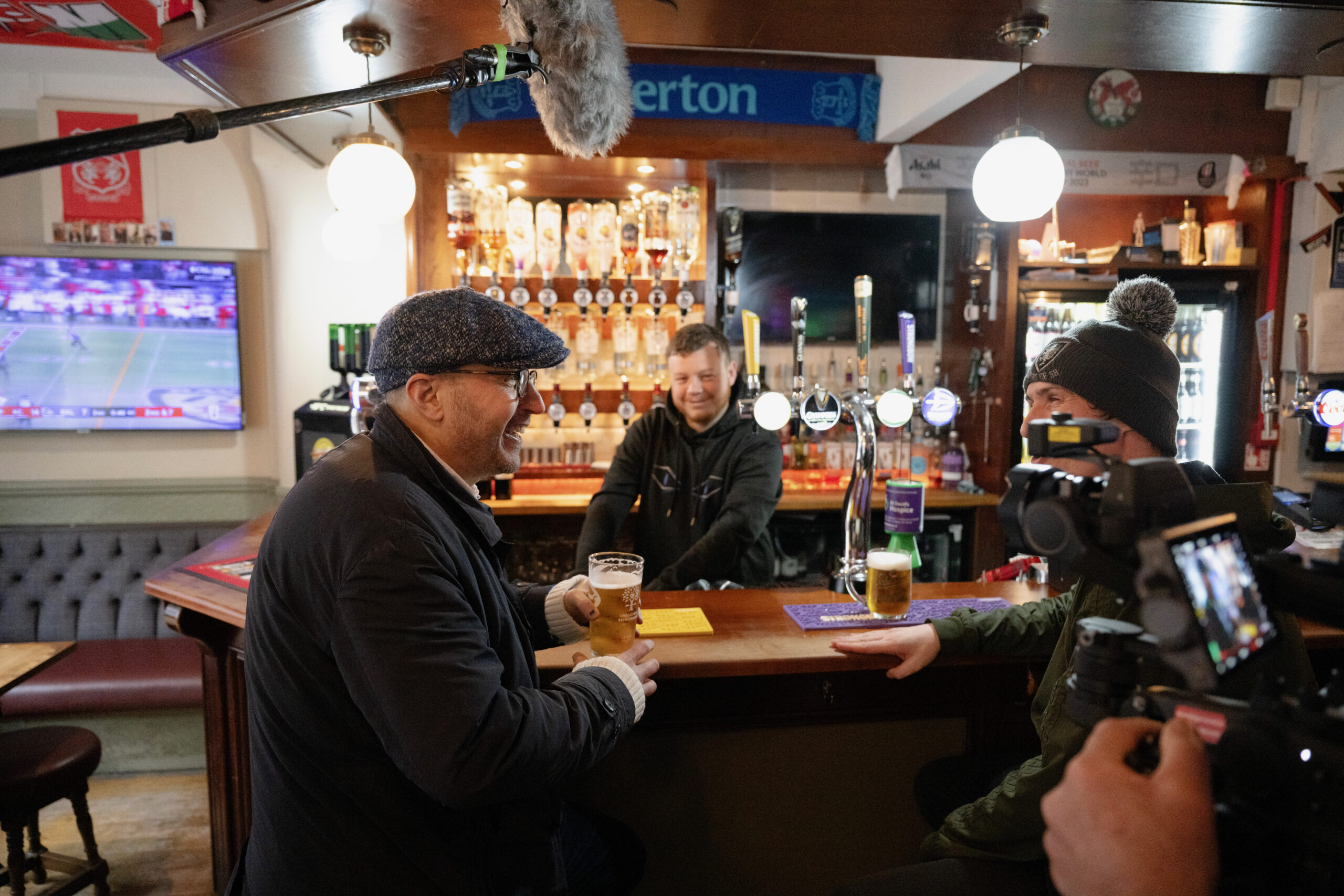Going Grassroots: Men in Blazers Shoots This Week in Wrexham Digital Series With iPhones
The U.S. soccer digital brand delivers weekly coverage of the popular Welsh club
Story Highlights
The affinity for European club soccer in the U.S. is an interesting cult phenomenon. The love affair that has grown around Wrexham Football Club, though, is another level of implausible. The subject of popular FX documentary series Welcome to Wrexham, the lower-tier Welsh club has attracted attention from across the world in a way that would have seemed impossible just a couple of years ago.
With so much hype surrounding the club’s dramatic rise, other content creators are looking to take fans inside its story. Enter the digital brand Men in Blazers Media Network.

Steven Ellis, head of production on Men in Blazers’ digital series This Week in Wrexham, shoots a significant portion of the show’s footage with an iPhone 15 Pro.
Typically known for covering the latest in the English Premier League, the UEFA Champions League, and international competitions for a North American audience, Men in Blazers has been offering a weekly YouTube series taking viewers deeper into the drama — and the fun — that is Wrexham Football Club. In an interesting production wrinkle, the show’s crew is shooting the series almost exclusively with iPhone 15 Pros and handling the file-sharing and editing workflows in the cloud.
The series, which is sponsored by STōK Cold Brew Coffee, is hosted by Thomas Lewis, affectionately known as Tomi or Tomi Caws, a lifelong Wrexham supporter who has traveled with the team throughout decades of darkness, and these last few seasons of joy. It takes viewers on a journey inside matches, through the quaint streets of Wrexham, and on spirited away days. The 5- to 10-minute episodes deliver a whimsical yet insightful portrayal of the season, replete with humor and adoration for the small towns that serve as the bedrock of English football’s lower professional leagues.
“The [FX] series is excellent. Our show fills a very different hole,” says Steven Ellis, who leads production for the Men in Blazers Media Network and is a shooter on the series. “On the back of the [FX] series, there has been an exponential rise in fans in North America, and there’s no real way to follow the stories of the team and the players on a weekly basis. The [FX] series is out once a year, after the fact. We’re not trying to compete; they’re outstanding. [We do] more of a lighthearted approach to telling the story around the team, the town, and the fans in a weekly episode.”
The Improbable Protagonists
There are plenty of institutions (the English Premier League, UEFA Champions League) and legendary players (Lionel Messi, Cristiano Renaldo) that deserve credit for attracting U.S. audiences to international soccer. Along the way, however, a more “working-class” Men in Blazers has played a critical role in educating them on the modern mythology of English football.
Founded as a podcast in the days of ESPN’s Grantland in 2010 by television producer Michael Davies and journalist Roger Bennett, Men in Blazers rolled out an informative and often hilarious welcome mat for North American fans new to the English Premier League. The podcast soared to superstardom during the 2014 FIFA World Cup and went mainstream when the show went to TV following a partnership with NBC Sports, which acquired U.S. broadcast rights to the Premier League in 2014. Since then, Bennett has become an icon in the U.S. soccer community.
These days, Men in Blazers is a full-fledged media company with multiple podcasts, digital series, and talent, including transfer specialist Fabrizio Romano, New York Times chief soccer correspondent Rory Smith, and U.S. Men’s National Team captain Tyler Adams. It even recently hired former USWNT star and FIFA World Cup champion Sam Mewis to serve as editor-in-chief of its women’s football coverage.
The global popularity of Wrexham Football Club, on the other hand, might be one of the more unlikely love affairs in sports today: a small-town Welsh soccer club in the lower levels of the English football-league system made popular by a comic-book antihero, one of the guys from It’s Always Sunny In Philadelphia, and a docu-series that has captured the hearts of viewers around the world.
FX’s Welcome to Wrexham, which chronicles the purchase of Wrexham A.F.C. by American actors Ryan Reynolds and Rob McElhenney and the club’s struggles to escape the dreaded National League, has become one of the more critically acclaimed sports-documentary series in recent memory. Produced by Boardwalk Pictures — the folks responsible for Netflix’s Last Chance U — it has won two Critics Choice Television Awards and five Primetime Emmy Awards. Its second season was completed in November, and its success has spurred emotional investment in this team, the town, and its people around the globe.
“[Because of the FX series], you’re getting people from all over the world coming to Wrexham every week,” says Ellis, noting that he has met visitors from New Zealand to Hawai‘i during filming. “Every week, we’re meeting new people. That’s not uncommon. They’re coming from all over the world because they’ve become so engrossed in the story. That’s what a powerful story can do, isn’t it?”
Why Shoot on iPhones?
It was a strategic decision when Ellis and the Men in Blazers team opted to shoot the series almost exclusively on the latest model of the Apple iPhone, the iPhone 15 Pro. Beyond the obvious budgetary advantages, the choice stems from a desire for intimacy and authenticity in storytelling. The iPhone’s picture quality and unassuming profile allow the crew to blend in with the community, capturing candid moments with fans and players alike.

The small iPhone rig includes a receiver for RØDE wireless GO II microphones worn by on-screen talent.
“We wanted this to be as intimate and authentic as possible,” explains Ellis, adding that he and his crew did trial some fixed-lens cameras and GoPros but they ultimately weren’t the right fit. “We wanted a low-key camera. Given how far the iPhone has come in terms of picture quality over the past few years, it is outstanding.”
With Tomi and on-screen guests outfitted with RØDE wireless GO II microphones, unsuspecting persons around them aren’t aware that a show is being shot. “We’re trying to get that first-person, intimate point of view, right in amongst the fans,” Ellis says. “If we’re in the pub next to the Racecourse Ground or in the stadium with the fans, we want to be able to feel as if we are literally in there. It was about being as inconspicuous as possible. People have iPhones everywhere.”
He adds that, when shooting in more-open areas, he will affix the iPhone to a rig for stabilization but, in closer quarters — such as in the stands or a crowded pub — he shoots freely with just his hand as any tourist would. There have even been circumstances when the iPhone was knocked from his hands and the resulting shots were used in the final cut of an episode.
“I’m not saying it’s better than [a professional camera] whatsoever,” he explains. “I’m just saying it’s different. It’s a different type of filmmaking. It’s a guerrilla type of filmmaking in a way. It feels quite liberating to shoot this way. I’ve directed hundreds of shoots, and this is the first time I’ve shot iPhone for a professional gig. I’ve really enjoyed it.”
Relentless Turnaround Time
With a super-tight turnaround on each episode, the production schedule is a whirlwind of activity. Shooting commences most Fridays and Saturdays, culminating in matches that wrap up around 5:00 p.m. Saturday. Ellis wastes no time in uploading footage to the cloud overnight, ensuring that editors can begin their work promptly the following morning.
Despite the geographical divide between the UK-based shooters and the Men in Blazers headquarters in New York City, the collaborative process with Bennett and Men in Blazers Executive Producer Jonathan Williamson remains seamless. In a meticulously choreographed ballet of scripting, editing, and feedback, each episode undergoes multiple iterations before reaching its final form.
“It’s pretty relentless,” says Ellis, “but what makes it doable is that we’ve got such an engaged team in Men in Blazers, who are so passionate about this project. They’re all over it in a great way. Roger and Jonathan have a great eye for story. It’s an open dialogue, and, since their audience is primarily American, there are nuances to their audience, and we need to lean on their expertise for that.”
Editors download and log all the footage beginning Sunday morning — a process that takes the crew through Monday. As video clips are selected, a first version of the show’s script goes to the editors by midafternoon Monday.

Men in Blazers founder Roger Bennett (left) occasionally makes appearances in episodes of This Week in Wrexham. Here he sits down for a pint with the show’s primary host, Thomas Lewis (right).
Editors try to give the U.S. side a look at the script by 9 p.m. UK time, putting it in New York hands in the afternoon. Amendments to the script are in by Tuesday morning in the UK, and official editing of the show begins. A first cut of the show is produced by Tuesday evening in the UK, giving the U.S. side time to review it in late afternoon and early evening.
Feedback is sent in overnight, and final changes are made until midafternoon Wednesday, when the assistant editor begins adding elements like subtitling and graphics. A second round of changes on that version come in on Thursday morning in the UK, with final edits typically completed by that afternoon.
In a typical week, master files are delivered by 5 p.m. UK time on Thursday. The episode is posted, and the crew begins shooting another episode on Friday.
“This would be much more difficult if the team wasn’t so engaged and so passionate about the project,” stresses Elliot.
Continued Growth of the Club’s Popularity
Despite the differences in the formats, the timelines, and the equipment used to produce each of FX’s Welcome to Wrexham and Men in Blazers’ This Week in Wrexham, there are some inevitable commonalities.
For Ellis, amidst the frenzy of production, that common thread is abundantly clear: the palpable sense of positivity and camaraderie permeating the town of Wrexham. Despite years of hardship and uncertainty, the club’s resurgence has become a beacon of hope for loyal supporters and draws admirers from all corners of the globe: “One of the first things that hit me when we started shooting in Wrexham is an incredible feel-good factor in the town. Although the people are very resilient, they have had a tough time following their team. A lot of them live and breathe for Saturday. To see the town and the team doing so well is amazing.”
Continuing to capture hearts and minds, the digital series serves as a poignant reminder of the enduring power of storytelling. In the unlikeliest of places, amidst the hustle and bustle of grassroots football, a tale of resilience, passion, and triumph unfolds — one iPhone shot at a time.
